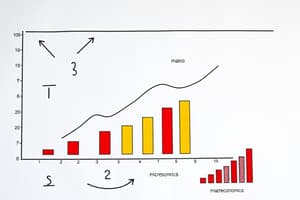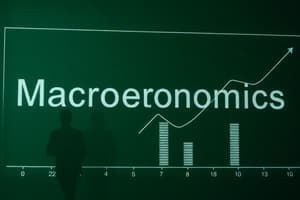Podcast
Questions and Answers
What is the purpose of tariffs and quotas in international trade?
What is the purpose of tariffs and quotas in international trade?
- To enhance the balance of payments by increasing exports.
- To increase the quantity of goods traded freely between countries.
- To restrict or control the flow of goods across borders. (correct)
- To regulate the exchange rate between currencies.
Which economic theory emphasizes the importance of government intervention to influence economic activity?
Which economic theory emphasizes the importance of government intervention to influence economic activity?
- Keynesian Economics (correct)
- Behavioral Economics
- Classical Economics
- Neoclassical Economics
How do exchange rates influence international trade?
How do exchange rates influence international trade?
- They eliminate trade deficits between countries.
- They determine the value of currencies in relation to one another. (correct)
- They fix the prices of goods in local currencies.
- They stabilize the economy by preventing inflation.
What does income inequality refer to in the context of international economics?
What does income inequality refer to in the context of international economics?
What is a primary goal of sustainable development in economics?
What is a primary goal of sustainable development in economics?
What is the focus of microeconomics?
What is the focus of microeconomics?
Which economic system relies on a central authority making all economic decisions?
Which economic system relies on a central authority making all economic decisions?
What does the opportunity cost represent?
What does the opportunity cost represent?
Which market structure consists of few firms that dominate the market?
Which market structure consists of few firms that dominate the market?
What is GDP an indicator of?
What is GDP an indicator of?
What does fiscal policy primarily involve?
What does fiscal policy primarily involve?
In which type of economy do decisions arise from the interaction of buyers and sellers?
In which type of economy do decisions arise from the interaction of buyers and sellers?
What is a characteristic of monopolistic competition?
What is a characteristic of monopolistic competition?
Flashcards are hidden until you start studying
Study Notes
Basic Concepts of Economics
- Definition: Economics is the study of how individuals, businesses, and governments allocate scarce resources.
- Branches:
- Microeconomics: Focuses on individual and business decision-making.
- Macroeconomics: Examines the economy as a whole, including inflation, unemployment, and growth.
Key Economic Principles
- Supply and Demand: The relationship between the quantity of a good that producers are willing to sell and the quantity that consumers are willing to buy.
- Opportunity Cost: The cost of forgoing the next best alternative when making a decision.
- Economic Incentives: Factors that motivate individuals and businesses to make decisions (e.g., profit motive, taxes).
Types of Economies
- Traditional Economy: Based on customs and traditions; often focuses on agriculture.
- Command Economy: Central authority makes all economic decisions (e.g., communism).
- Market Economy: Decisions are made through the interaction of buyers and sellers in the marketplace.
- Mixed Economy: Combines elements of both market and command economies.
Economic Systems
- Capitalism: Private ownership of resources and businesses; market-driven economy.
- Socialism: Social ownership or regulation of the means of production; focus on equal distribution of wealth.
- Communism: Classless system where all property is owned communally; aims to eliminate private ownership.
Economic Indicators
- Gross Domestic Product (GDP): The total value of all goods and services produced in a country; indicator of economic health.
- Inflation Rate: Measures the rate at which the general price level of goods and services rises, eroding purchasing power.
- Unemployment Rate: The percentage of the labor force that is unemployed and seeking employment.
Market Structures
- Perfect Competition: Many firms, identical products, no barriers to entry.
- Monopolistic Competition: Many firms, differentiated products, some control over prices.
- Oligopoly: Few firms dominate the market, potential for collusion, can set prices.
- Monopoly: Single firm controls the entire market; no close substitutes.
Fiscal and Monetary Policy
- Fiscal Policy: Government policies on taxation and spending to influence the economy.
- Monetary Policy: Central bank actions that manage the money supply and interest rates.
International Economics
- Trade: Exchange of goods and services between countries; can be influenced by tariffs and quotas.
- Exchange Rates: The value of one currency in relation to another; determines trade dynamics.
- Balance of Payments: Record of all economic transactions between residents of a country and the rest of the world.
Economic Theories and Models
- Classical Economics: Emphasizes free markets, self-regulating nature of economies.
- Keynesian Economics: Focuses on total spending and its effects on output and inflation; supports government intervention.
- Neoclassical Economics: Centers on the determination of goods, outputs, and income distributions through supply and demand.
Current Issues in Economics
- Globalization: Increasing interconnectedness of economies; impacts job markets and trade.
- Income Inequality: The disparity in wealth distribution within and between countries.
- Sustainable Development: Balancing economic growth with environmental protection and social equity.
Basic Concepts of Economics
- Economics studies how scarce resources are allocated among individuals, businesses, and governments.
- Microeconomics focuses on individual and business decision-making, while macroeconomics examines the economy as a whole.
Key Economic Principles
- Supply and demand are fundamental forces that determine the prices and quantities of goods and services.
- Opportunity cost is the value of the next best alternative forgone when making a decision.
- Economic incentives influence decisions by individuals and businesses, such as profit motives or taxes.
Types of Economies
- Traditional economies rely on customs and traditions, often focusing on agriculture.
- Command economies centralize economic decision-making under a central authority.
- Market economies rely on the interactions of buyers and sellers in the marketplace.
- Mixed economies combine elements of both market and command economies.
Economic Systems
- Capitalism emphasizes private ownership of resources and businesses, with a market-driven economy.
- Socialism emphasizes social ownership or regulation of production, aiming for equal wealth distribution.
- Communism strives for a classless society with communal ownership, aiming to eliminate private property.
Economic Indicators
- Gross Domestic Product (GDP) is the total value of goods and services produced within a country, measuring economic health.
- Inflation Rate measures the increase in the general price level, impacting purchasing power.
- Unemployment Rate indicates the percentage of the workforce unemployed but actively seeking work.
Market Structures
- Perfect competition involves many firms offering identical products with no barriers to entry.
- Monopolistic competition has many firms offering differentiated products with some price control.
- Oligopoly involves a few dominant firms, potentially leading to collusion and price setting.
- Monopoly grants a single firm control over the entire market, lacking close substitutes.
Fiscal and Monetary Policy
- Fiscal policy uses government taxation and spending to influence the economy.
- Monetary policy, enacted by central banks, manages the money supply and interest rates.
International Economics
- Trade involves exchanging goods and services between countries, influenced by factors like tariffs and quotas.
- Exchange rates determine the value of one currency relative to another, impacting trade dynamics.
- Balance of Payments records all economic transactions between a country and the rest of the world.
Economic Theories and Models
- Classical economics emphasizes free markets and self-regulating economic forces.
- Keynesian economics focuses on total spending's influence on output and inflation, advocating government intervention.
- Neoclassical economics centers on supply and demand, explaining the determination of goods, outputs, and wealth distribution.
Current Issues in Economics
- Globalization increases economic interconnectedness, impacting job markets and trade flows.
- Income Inequality refers to the disparity in wealth distribution within and between countries.
- Sustainable Development prioritizes balancing economic growth with environmental protection and social equity.
Studying That Suits You
Use AI to generate personalized quizzes and flashcards to suit your learning preferences.




